Bài giảng Nghệ thuật lãnh đạo - Chapter 5: Leading Change
Content
Forces for change
Types and process of change
Resistance to change and solutions
Leading change
Creativity and improvisation
Changing how organizations approach change
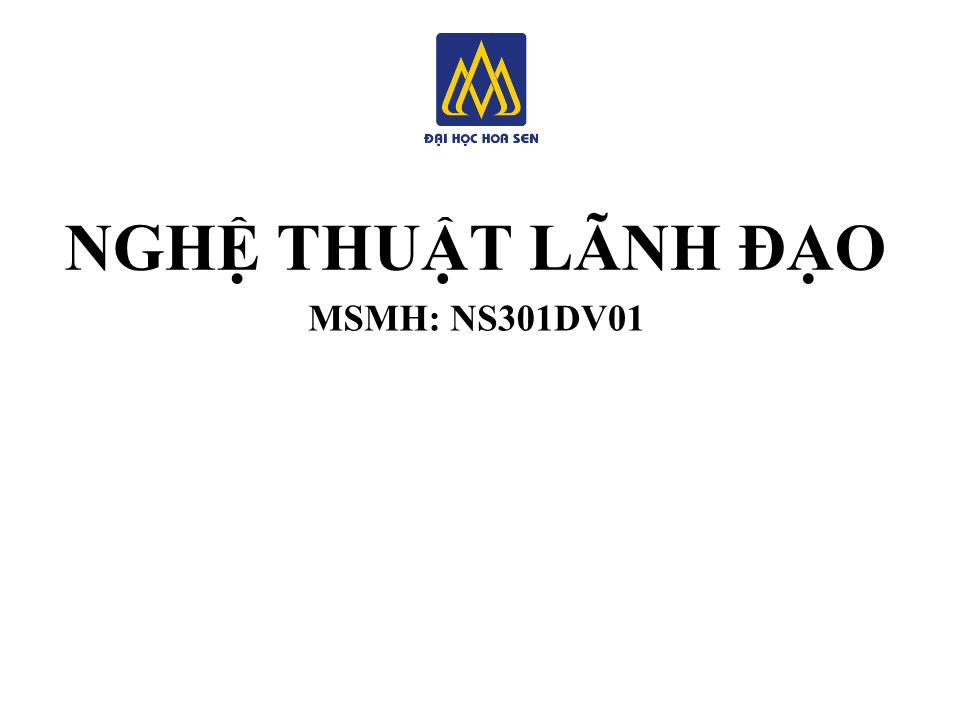
Trang 1
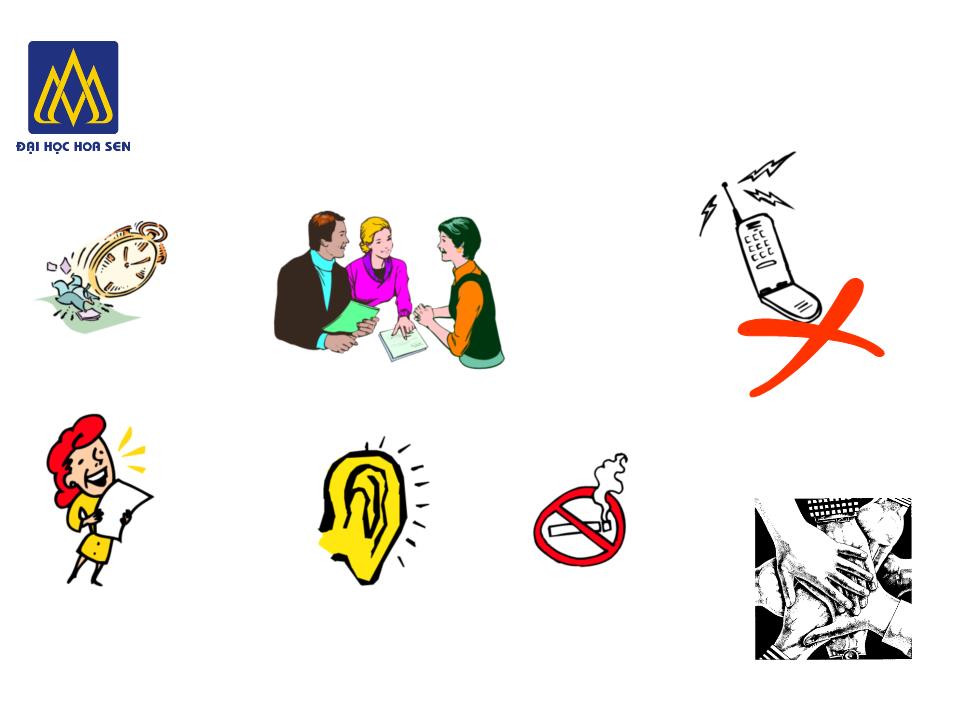
Trang 2
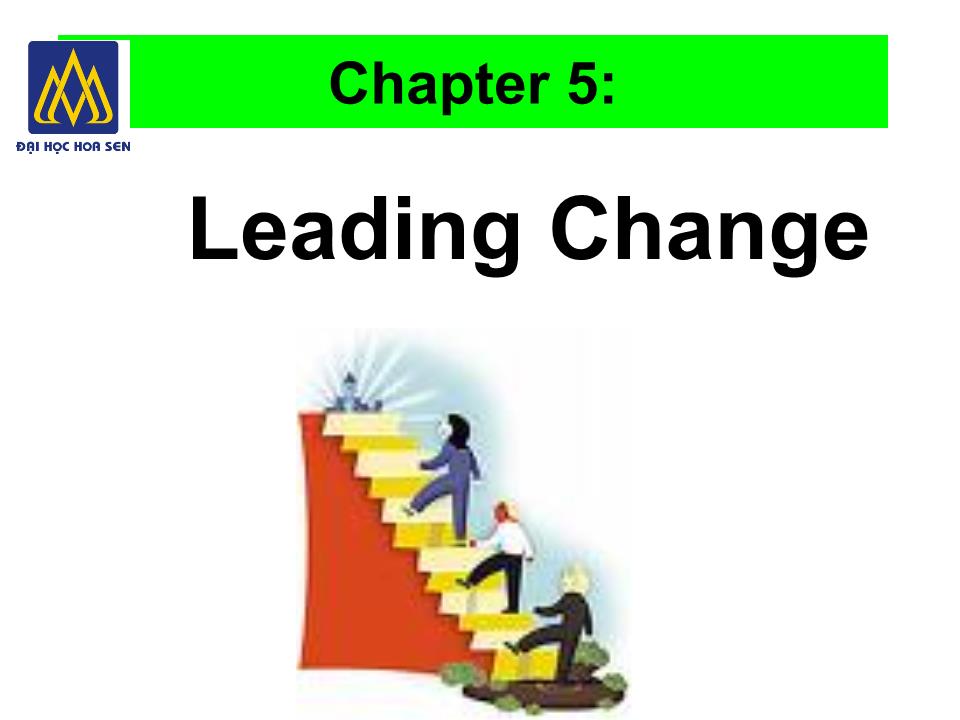
Trang 3
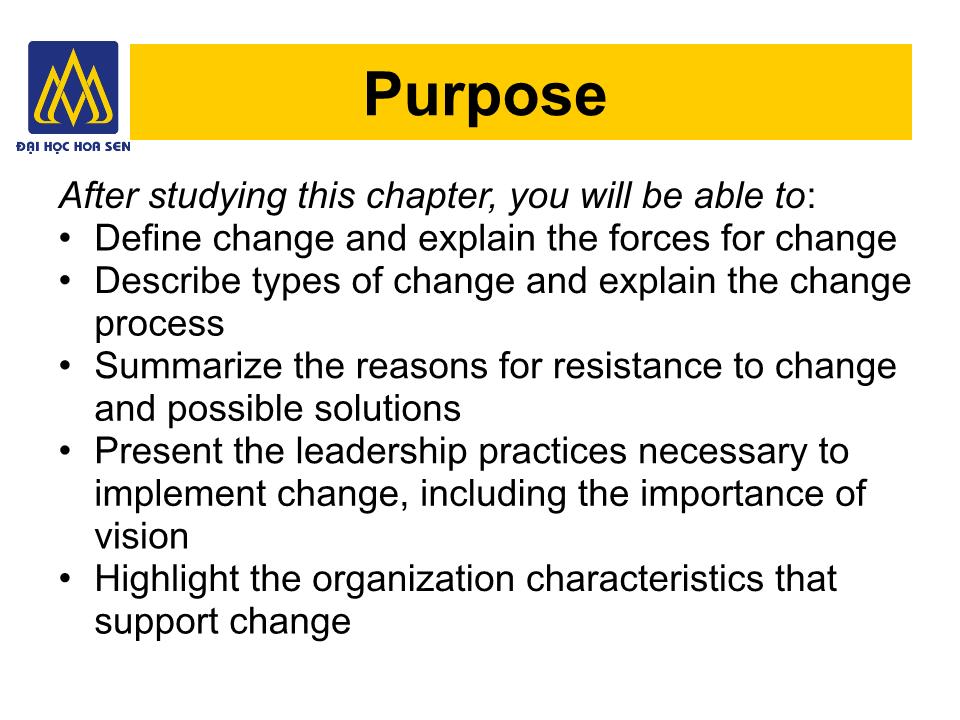
Trang 4
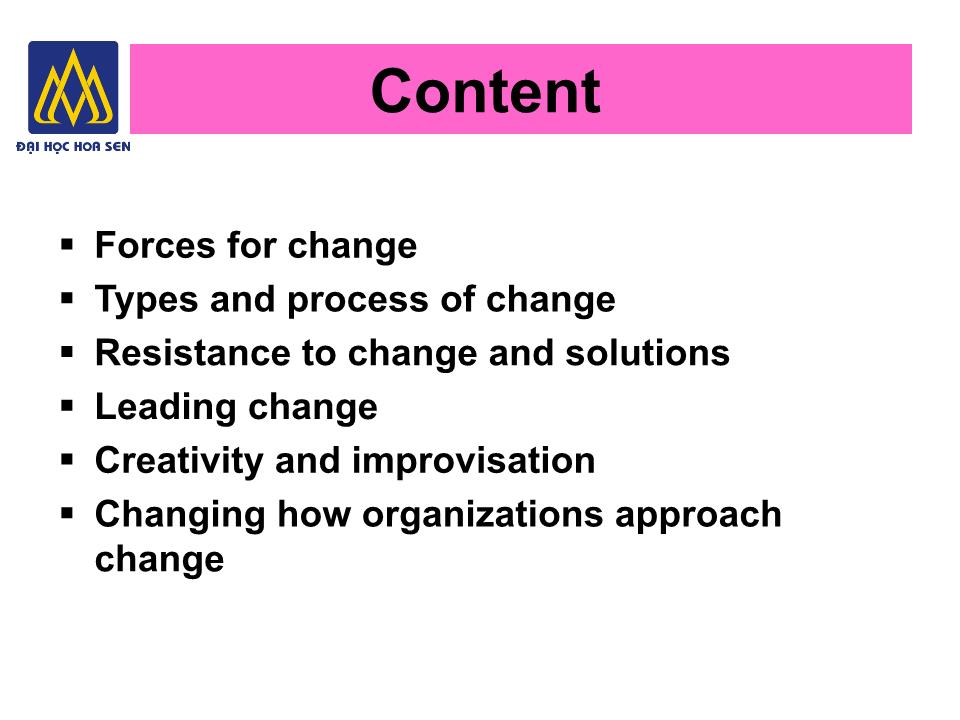
Trang 5

Trang 6
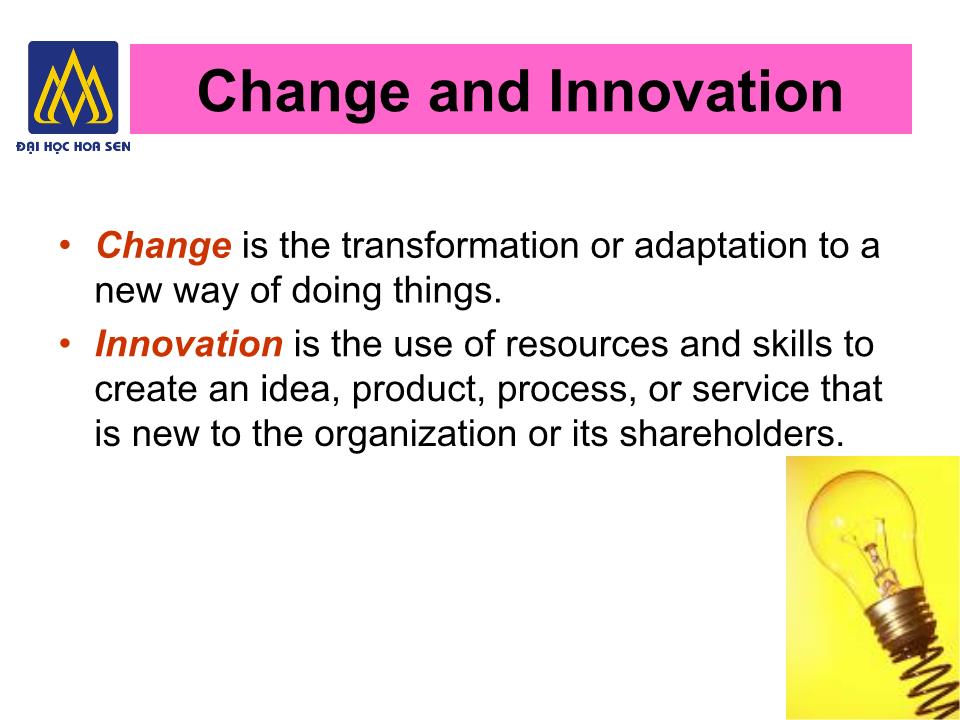
Trang 7
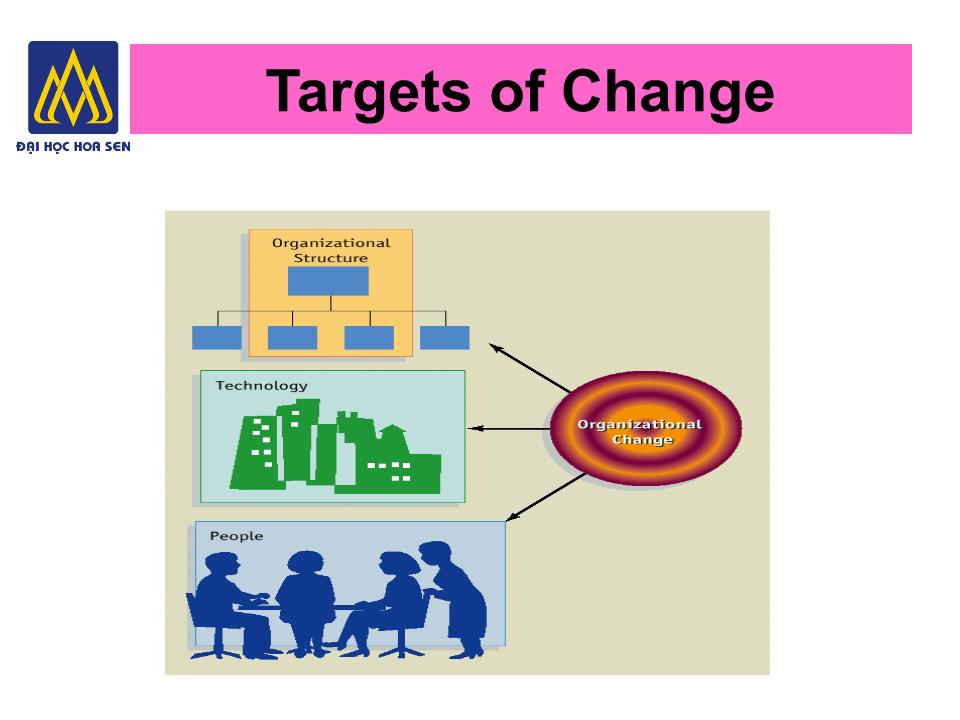
Trang 8

Trang 9

Trang 10
Tải về để xem bản đầy đủ
Bạn đang xem 10 trang mẫu của tài liệu "Bài giảng Nghệ thuật lãnh đạo - Chapter 5: Leading Change", để tải tài liệu gốc về máy hãy click vào nút Download ở trên
Tóm tắt nội dung tài liệu: Bài giảng Nghệ thuật lãnh đạo - Chapter 5: Leading Change

NGHỆ THUẬT LÃNH ĐẠO MSMH: NS301DV01 Chapter 5: Leading Change Purpose After studying this chapter, you will be able to : Define change and explain the forces for change Describe types of change and explain the change process Summarize the reasons for resistance to change and possible solutions Present the leadership practices necessary to implement change, including the importance of vision Highlight the organization characteristics that support change Content Forces for change Types and process of change Resistance to change and solutions Leading change Creativity and improvisation Changing how organizations approach change Chapter 5 5.1- Forces for Change Change and Innovation Change is the transformation or adaptation to a new way of doing things. Innovation is the use of resources and skills to create an idea, product, process, or service that is new to the organization or its shareholders. Targets of Change Forces for Change Forces for change are both external (in the environment) and internal. Changes in the environment include factors such as social trends, cultural and demographic changes, political shifts, the economy, and technological advances. Force for change inside organizations is the performance gap – the difference between expected and actual performance, the new leadership at any level. Forces for Change Chapter 5 5.2- Culture and Change Culture and Change As pressure for change increases from inside and outside of organizations, not all leaders react and respond the same way. Some perceive the pressure as a threat; others see it as an opportunity. One factor that determines the way leaders and their followers perceive pressures for change is culture , both at the national and organizational levels. Culture and Change In cultures where people do not easily tolerate uncertainty and ambiguity , pressure for change is seen as a threat , and is either ignored or carefully planned and managed. In cultures where change is tolerated and perceived as an opportunity , leaders deal with change by making quick changes to their organizations, and implementing short-term strategies that address the immediate pressures relatively more quickly than in other cultures. Culture and Change Leaders from present-oriented cultures , where time is linear, are likely to react fairly quickly to change and focus on short-term planning. Leaders from past- and future-oriented cultures are less likely to react quickly to change , taking time to plan and to consider the long-term impact of their actions. Chapter 5 5.3- Types and Process of Change Types of Change Types of Change Description Planned Change that occurs when leaders or followers make a conscious effort to change in response to specific pressure or problem. Unplanned Change that occurs randomly and suddenly without the specific intention of addressing a problem. Evolutionary Gradual or incremental change. Convergent Planned evolutionary change that is the result of specific and conscious actions by leaders of followers to change the organization. Revolutionary or frame-breaking Change that is rapid and dramatic. Model for Change Kurt Lewin's Model of Change: a three-stage process Unfreezing : Changing : Refreezing : Lewin's Model of Change Unfreezing : The existing practices and behaviors are questioned, and motivation to change develops. Leaders help followers “unfreeze” and realize that there is a need for change. Lewin's Model of Change Changing : New practices and policies are implemented, and new behaviors and skills are learned. Leaders support followers, emphasize the importance of the change, correct the course as needed Lewin's Model of Change Refreezing : The newly learned behaviors and freshly implemented practices are encouraged and supported to become part of the employees’ routine activities. Leaders coach, provide training, and use appropriate reward systems to help solidify the changes that have been implemented. Lewin's Model of Change Lewin’s model of change has 4 key characteristics that leaders must consider: The importance of recognizing the need for change and preparing and motivating followers to implement it. The inevitable presence of the resistance to change . The focus on people as the source for learning and changing The need to support new behaviors and allowing them to take hold. Process of Planned Change The process has 6 steps , each of which requires different types of resources and leadership skills. Step 1 – Recognition of need for change : mirrors the unfreezing phase of Lewin's model. Leaders and followers must become aware of the need for change, and recognize its importance to organization’s effectiveness or survival *performance gap, employee dissatisfaction, external pressure from customers or competitors Step 2 – Development of alternatives and ideas for change : can be done by organizational leaders at different levels, through small groups or teams, or even with participation of outsiders. Process of Planned Change Step 3 & 4 – Adoption of ideas, and implementation of the change plan : mirrors Lewin’s change phase. Step 5 – Allocation of resources : Leaders have either to allocate new resources or shift current resources to help implement change and “freeze” the change. Step 6 – Evaluation of the change process and its outcomes : The process of change is a continuous and dynamic loop. After change is implemented, the organization must review and evaluate its effectiveness, and assess whether the objectives are met. If the goals are not achieved, the change process starts over with the recognition once again of the need to change. Dealing with Unplanned Change Change is frequently sudden, unpredictable, and not planned : the economy changes, competitors come up with a new product, an environmental disaster happens, or unions go on strike Managing unplanned change falls into the domain of crisis management. A crisis occurs when leaders and their organizations substantially misread their environment or are caught off guard by events they could not have foreseen. Dealing with Unplanned Change Leaders can manage unplanned change to some extent by taking the following steps before a crisis develops: Avoid allowing the organization from becoming too formal, hierarchical, rigid, and inflexible. Infuse moderate amount of unreliability, unpredictability, and spontaneity into decisions to help prevent complacency. Stay on the offensive and be proactive with introducing new strategies, products, services, or processes. Replace and rotate leaders to bring it new ideas, methods, and visions. Experiment often with new methods, products, processes, structures to help followers practice dealing with change. Chapter 5 5.4- Resistance to Change and Solutions Resistance to Change The tendency for employees to be unwilling to go along with organizational changes, either because of individual fears of the unknown, or organizational impediments. Resistance to Change Causes of Resistance Organizational Causes Inertia Culture Structure Lack of rewards Poor timing Previously unsuccessful change efforts Causes of Resistance Group Causes Work group inertia Group norms Group cohesion Threats to existing balance of power Causes of Resistance Individual Causes Fear of the unknown Fear of failure Job insecurity Individual characteristics Previous experience Solutions Education and communication provide information and training through a variety of means, including face-to-face communication, newsletters, training sessions, and announcements. Providing information can help reduce fear of the unknown, and train people for the new tasks and jobs. It can also build trust. Participation and involvement rely on getting input from those affected by the change to plan and implement it. Participating in the change process is one of the most effective methods of building commitment to the change. Facilitation and support involve active listening and supportive communication in the form of counseling and support for followers. They can be highly effective in reducing fear. Solutions Negotiation and agreement engage powerful parties who can block the change in discussion about planning and implementation offering incentives and trade-off in exchange for acceptance of the change. Manipulation and cooperation focus employees’ attention on other factors, hoping to bypass resistance of get them on-board by bribing them. Coercion relies on threats, fear, and force to push through the resistance. Methods of Dealing With Resistance to Change Method When to use Advantages Disadvantages Education and communication When there is lack of information, and fear of the unknown, in all phases of the change process. Provide facts, and once persuaded, people are less likely to resist. Time-consuming when large number of people are involved Participation and involvement When people do not have all the information, or when they have power to block implementation, in all phases of the change process. Lead to commitment, and can provide richer alternatives and ideas. Time-consuming, risk of inappropriate change being implemented. Methods of Dealing With Resistance to Change Method When to use Advantages Disadvantages Facilitation and support When people are resisting because of factors, such as fear, during the change and refreezing phases. The only option when adjustment is the cause of resistance. Time-consuming and high risk of failure. Negotiation and agreement When there can be winners and losers and groups and individuals have power, during the change and refreezing phases. Relatively easy to implement; only option to balance power. Can be expensive, time-consuming and lead to continued and further negotiation. Methods of Dealing With Resistance to Change Method When to use Advantages Disadvantages Manipulation When nothing else works or other options are too expensive; during the change phase. Relatively quick and inexpensive. Can lead to mistrust, and resentment. Explicit or implicit coercion When there is no time and nothing else works; when others have power; use occasionally; during unfreezing and change. Can be fast and effective in short term to end resistance. Can lead to resentment and morale problems; only effective in the short-term. Chapter 5 5.5- Leading Change Visionary Leadership Providing a vision and inspiring followers are one of the most important functions of leaders during change. A clear vision provides followers with reasons for change, supports the actual change process, helping followers keep the goals in mind, and help them stay focused during refreezing. The inspiration that a leader can provide to followers sustains them, and helps reduce the resistance to change. Visionary Leadership Visionary leadership essential to change: Importance of vision . Successful and effective leaders provide a clear vision or help followers develop a common vision. Empowerment and confidence in followers . Visionary leaders emphasize empowering followers to allow then to act autonomously and independently from the leader. This empowerment is possible only if leaders show genuine confidence in their followers. Flexibility and change . Teamwork and cooperation . Successful leaders emphasize teamwork and, may be more important, the development of shared responsibility, as well as the need for trust and cooperation between leaders and followers and among followers. Visionary Leadership Leaders communicate their vision and values through stories. “ Who am I ” who the leader is. “ Who we are ” “ Where we are going ” Visionary Leadership A motivating vision is clear and understandable, challenging, idealistic yet achievable; it appeals to emotions and is forward-looking. In order to truly motivate and inspire followers, the leader must do the following: Set clear standards for behaviors and performance that are accepted by all followers. Expect the best from followers through a genuine beliefs in their abilities. Pay attention by being present, walking around, noticing followers, and caring about their behaviors, actions and results. Personalize recognition not only by considering each followers’ needs and preferences, but also by making them feel special in the process. Tell a story about followers, events and performance, as a way to motivate and teach. Celebrate together . Leaders must look for many opportunities to celebrate the team and the individual’s success together. Role model the preceding principles to gain credibility and reinforce the message. Practices of Exemplary and Visionary Leadership Chapter 5 5.6- Creativity and Improvisation Creativity Creativity , also called diversity or lateral thinking , is the ability to link or combine ideas in novel ways. Creative people tend to be confident in the paths they select and are willing to take risks when others give up. They focus on learning and are willing to live with uncertainty to reach their goals. Creativity Leaders can put in place several processes to help their followers be more creative and accept change more readily: Leadership style . Autocratic leaders who demand obedience impede the creative process and open exchange that encourage creativity. Flexible structure . Less centralized and less hierarchical structures allow for free flow of ideas. Open organizational culture . Being creative and seeking novel solutions is more likely in cultures that values change and constructive deviance, rather than tradition and conformity. Questioning attitude . Leaders can encourage and inspire followers to question assumptions and norms, and look for novel alternatives, instead of rewarding agreement and obedience. Tolerating mistakes . By encouraging experimentation, tolerating, and even rewarding some mistakes, the leader can send a strong message about the importance of taking risks. Improvisation Improvisation involves creation of something spontaneously and extemporaneously without specific preparation. occurs without a script and without perfect information, and requires a combination of pre-planned and un-planned activities and materials. Improvisation Leaders must have expertise, knowledge, and perspective on the situations , because without these elements, the leader is not likely to understand the leadership situation and environment enough to be able to lead. Chapter 5 5.7- Changing How Organizations Approach Change Changing how organizations approach change The most basic and essential steps to successful change is to design organizations that are built to change (Worley and Lawler, 2006), and have cultures that are ready to change (Wall, 2005). Learning Organizations Learning organizations are organizations that are successful at acquiring, cultivating, and applying knowledge that can be used to help it adapt to changes. Learning organizations do not simply manage change; their goal is to become a place where creativity, flexibility, adaptation, and learning are integral parts of the culture and everyday processes . Core Elements of Learning Organizations Element Description Shared vision Using cooperation and openness to build a shared vision through a common identity and a common goal of the future that leads to commitment. System thinking Understanding inter-relations, and the invisible and visible bonds that connect people inside and outside the organization. Mental models Being aware of stated and unstated assumptions and mental models that guide behaviors and decisions, and developing new ones based on openness and cooperation. Personal mastery Continually clarifying and developing personal visions and goals, and expanding skills sets and levels of proficiency. Team learning Developing synergy and the ability to think and work together to question assumptions, and build new processes. Blocks to Learning Organizations Blocks to Learning Organizations To support organizations in being change ready and become learning organizations, leaders can take several actions to build an open and supportive culture that will support ongoing transformation” Openness to new ideas . Welcoming and encouraging new ideas; this involves role modeling, tolerance for a questioning attitude, and supporting and rewarding openness. Local solutions . Encouraging and allowing each person, team, or department at every level of the organization to find and implement its own solution without focusing on standardization. Time for learning . Providing organizational members time and resources to learn new ideas and experiment with a focus on long-term rather than short-term results. Appropriate leadership . leading organizations by inspiring a shared vision, providing guidance, support, and service, rather than imposing a top-down vision and solutions. Role of Leader in Changing Organizational Culture Communicate priorities . By stating what is important, in terms of general vision, specific issues that must be addressed, and ways in which they must be addressed. Role model . Although what the leader says is important, even more powerful is what the leader does. Leaders must be the change they want to see. Their actions demonstrate their values and what is truly important. Allocate resources and rewards . By rewarding compliance and conformity, by promoting individuals who demonstrate the values and mission of the organization. Questions ?
File đính kèm:
 bai_giang_nghe_thuat_lanh_dao_chapter_5_leading_change.ppt
bai_giang_nghe_thuat_lanh_dao_chapter_5_leading_change.ppt

